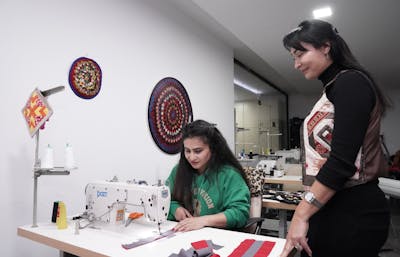Types of Finishing Processes in Textile Manufacturing
The finishing process is a crucial step in textile manufacturing, transforming raw fabrics into finished goods ready for consumer use. These processes enhance the fabric’s aesthetic appeal, functionality, and durability, ensuring that textiles meet the required standards and consumer expectations. In this blog, we’ll explore the various types of finishing processes commonly used in the textile industry.
What is Textile Finishing?
Textile finishing encompasses a range of treatments applied to fabrics after weaving or knitting to improve their appearance, performance, and feel. These processes can be mechanical, chemical, or thermal, depending on the desired properties of the final product.

Types of Finishing Processes
1. Mechanical Finishing
Mechanical finishing involves physical processes to alter the fabric’s structure or surface. Common mechanical finishes include:
Calendering
– Description: Fabrics are passed through heated rollers to produce a smooth, glossy surface.
– Applications: Used for fabrics like cotton, linen, and synthetics to enhance sheen and smoothness.
Brushing
– Description: The fabric surface is brushed to raise fibers, creating a soft, fuzzy texture.
– Applications: Commonly used for flannels, fleeces, and other fabrics intended for warmth and comfort.
Sanforizing
– Description: A mechanical process that pre-shrinks fabric to prevent further shrinkage during washing.
– Applications: Widely used for cotton and other natural fiber fabrics.
Embossing
– Description: Patterns are pressed into the fabric using engraved rollers, creating a raised design.
– Applications: Often used for decorative purposes on fabrics for garments, upholstery, and accessories.
2. Chemical Finishing
Chemical finishing involves applying chemical treatments to fabrics to achieve specific properties. Common chemical finishes include:
Mercerizing
– Description: Fabrics are treated with caustic soda to increase luster, strength, and dye affinity.
– Applications: Primarily used for cotton fabrics.
Flame Retardant Finishing
– Description: Chemical treatments are applied to make fabrics resistant to ignition and slow the spread of fire.
– Applications: Used for upholstery, curtains, children’s sleepwear, and protective clothing.
Water Repellent Finishing
– Description: Chemicals are applied to create a hydrophobic surface that repels water.
– Applications: Ideal for outdoor gear, rainwear, and sportswear.
Anti-Microbial Finishing
– Description: Fabrics are treated with anti-microbial agents to inhibit the growth of bacteria and fungi.
– Applications: Commonly used for medical textiles, sportswear, and home textiles.
3. Thermal Finishing
Thermal finishing uses heat to change the properties of fabrics. Common thermal finishes include:
Heat Setting
– Description: Synthetic fabrics are heated to stabilize their shape and dimensions.
– Applications: Used for polyester, nylon, and other thermoplastic fibers to improve wrinkle resistance and dimensional stability.
Singeing
– Description: Fabrics are passed over a flame or heated rollers to burn off surface fibers, creating a smooth finish.
– Applications: Used for cotton, wool, and synthetic fabrics to enhance smoothness and reduce pilling.
4. Functional Finishing
Functional finishing processes impart specific properties to fabrics to meet specialized needs. Common functional finishes include:
UV Protection Finishing
– Description: Fabrics are treated with UV-absorbing chemicals to protect against harmful ultraviolet rays.
– Applications: Used for outdoor clothing, swimwear, and sun-protective garments.
Wrinkle-Resistant Finishing
– Description: Fabrics are treated with resins to prevent wrinkling and maintain a smooth appearance.
– Applications: Common in cotton and cotton-blend garments like dress shirts and trousers.
Soil Release Finishing
– Description: Chemical treatments are applied to make it easier to remove stains and dirt from fabrics.
– Applications: Used for workwear, children’s clothing, and home textiles.
5. Aesthetic Finishing
Aesthetic finishing enhances the visual and tactile appeal of fabrics. Common aesthetic finishes include:
Bleaching
– Description: Fabrics are treated with bleaching agents to remove natural color and achieve a uniform white base.
– Applications: Used for white garments, preparation for dyeing, and printing.
Dyeing
– Description: Fabrics are treated with dyes to achieve a desired color.
– Applications: Used for all types of textiles to achieve vibrant and diverse color ranges.
Printing
– Description: Designs and patterns are applied to fabrics using various printing techniques.
– Applications: Used for fashion fabrics, home textiles, and accessories to add decorative elements.
Takeaway
Textile finishing processes are vital for transforming raw fabrics into high-quality, functional, and aesthetically pleasing products. Whether through mechanical, chemical, thermal, or functional treatments, these processes enhance the fabric’s properties to meet the diverse needs of consumers and industries. By understanding and utilizing the appropriate finishing techniques, textile manufacturers can ensure their products stand out in the competitive market.
